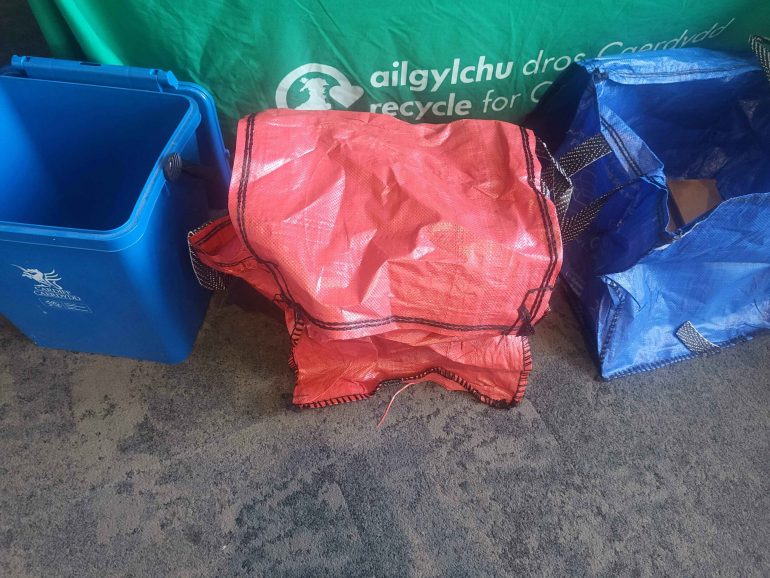The way 36,000 homes in Cardiff recycle their waste is changing. Find out if it affects you
A THIRD of households in Cardiff will have to swap their one green recycling bag for three new coloured bins – and face fines of £100 if they get it wrong.
On February 20 some 36,000 homes will adopt Cardiff Council’s new recycling scheme in the first stage of a city-wide rollout, following trials in eight areas across the city.
Homes included in the new scheme will receive new bins and a leaflet explaining how to use them by February 16. There is no date yet for the rest of the rollout.
Use the map below to see if your area is on the new trial.
So how might your bin collection be changing?
If you are moving to the new system you will now have to sort your recycling into three separate containers, instead of using the green bags.
There will be a blue plastic caddy, a red sack and a blue sack.
The blue caddy is for glass bottles and jars and it will be collected every two weeks on the same day as your general waste collection. The council says that one blue plastic caddy can fit seven wine bottles.
The reusable red sack is for metal cans, tins, aerosols, foil, plastic bottles, pots, tubs, trays and food and drink cartons including Tetra Pak.
The reusable blue sack is for dry paper and cardboard. These will be collected weekly on your normal collection day.
There will be a three-week grace period before enforcement of a ‘pink sticker’ scheme. Pink stickers are left on bags or bins that are too heavy or contain incorrect items. If you receive three pink stickers in 12 weeks you are issued with a £100 fine.
Once the scheme starts in your area additional red and blue sacks will be available from your local hub and blue caddies can be ordered on the council website. Green bags will no longer be available or be collected from your property.
Why are your bins changing?
The new method is known as kerbside sorting, where residents sort their recycling before it is collected.
The council is switching to this system because their trial has shown a reduction in the contamination rate, where non-recyclables are put in the wrong bags or bins and contaminate recyclable material. The rate of contamination dropped from 30% to between 6% and 8% during the trial period.

A Cardiff Council spokesperson said: “The council is currently implementing a new sack sort recycling method to 36,000 properties across the city, following successful trials of 10,000 properties. The sack sort recycling method is Welsh Government’s preferred way for local authorities to collect recyclable waste, as outlined in their Towards Zero Waste Strategy.
Image credit: Cerys Gardner.
“Commingled recycling, where residents put all their recycling into one container, does make it easier for the customer, but the system is easily abused by people using the green bags to dispose of residual waste including food and nappies. This causes an issue at the kerbside where animals, birds and vermin open the bags to access the food, creating street litter.”
Splott Councillor Jane Henshaw said that the new scheme will also stop the use of 24 million non-recyclable green plastic bags a year.
The aim of the new system is to help Cardiff reach the Welsh Government target of recycling 70% of waste by 2025. Currently 62% of waste is recycled.
Swapping to kerbside sorting has vastly improved recycling rates in other parts of Wales. Bridgend Council made the switch in June 2017 and the recycling rate there increased from 57.9% in 2016-17 to 68.6% in 2017-18. In 2022-23 their recycling rate was 71.4%, 10 percentage points higher than Cardiff.
What do residents think?
The new scheme has had a mixed response from people in Splott, an area that was part of the trial and moves fully to the new system on February 20.
Coun. Henshaw, who is already on the new system, said: “I definitely prefer the new scheme. I am much clearer about what can actually go in each bag. I was one of those people who put stuff in the recycling ‘just in case’. I thought I was being helpful. I wasn’t.”
However, resident Gail Sidaway said: “I don’t think it’s going to be good,”
Ms Sidaway is disabled and concerned about accessibility issues caused by the new system. If the bins are not put back in front of her house or blow away before she can collect them then she can’t chase after them.
The council said it offer an assisted lift system for those who need additional help. The bags also have 500 gram weights sewn in to try and stop them blowing away.
Amanda Preece said she is concerned about where she will store the bags because she lives in a terraced house, like many Splott residents.
Camilla, who didn’t want to give her surname, describes herself as “quite a green, environmental bunny”. She said: “I’m looking forward to it reaching my street.”
Peter Durrant, a founder of the Keep Splott Tidy litter picking group, said: “Once it gets going we should see a reduction in the amount of litter.”
Keep Splott Tidy has written a series of tips for people moving to the new system.
- If you have any additional questions about the new scheme the council are holding Q&A sessions in the areas moving to the new system. You can find the dates here.



